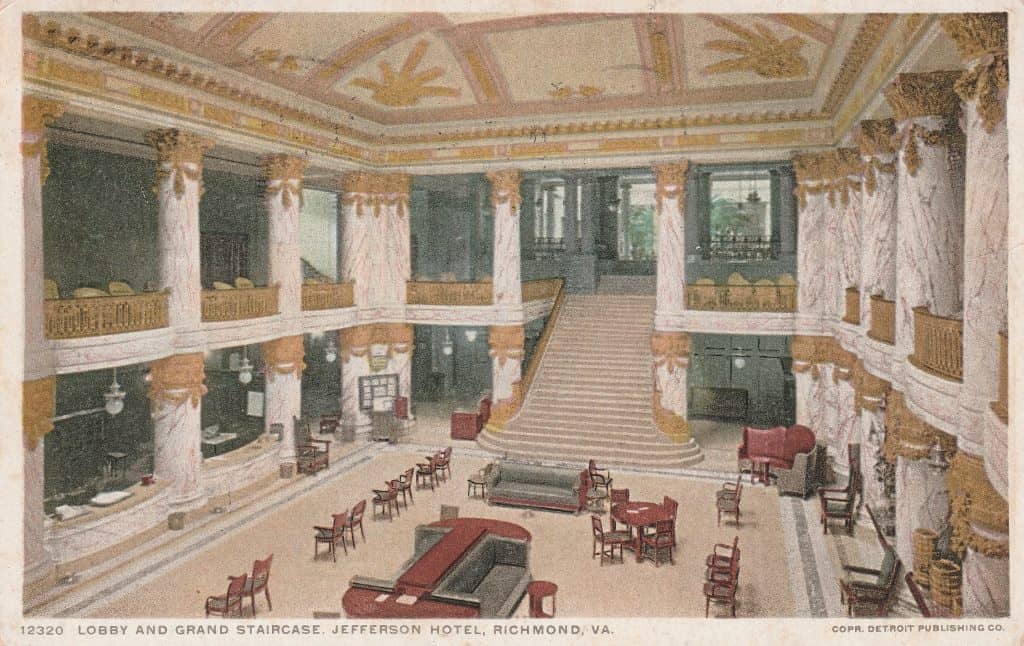
The Jefferson Hotel opened in 1895 and was a leading hotel in Richmond for several decades. Major Lewis Ginter, who made his fortune in the tobacco business, built the Jefferson. It combined beaux arts and renaissance revival architectural styles. In the lobby was a statue of the hotel’s namesake, Thomas Jefferson. By the 1970s, the hotel was down on its heels and closed in the early 1980s. The Jefferson was beautifully restored and reopened in the late 1980s. It is once again a premier hotel. A widely circulated Richmond urban legend about the Jefferson Hotel is that the lobby staircase was the model for the one in Scarlett O’Hara’s Atlanta mansion in the 1939 movie, Gone With The Wind. David Niven in his autobiography, The Moon’s a Balloon, stopped at the Jefferson in the 1930s, and to his surprise, he saw alligators swimming in a pool near the registration desk. The last alligator died in the 1940s.
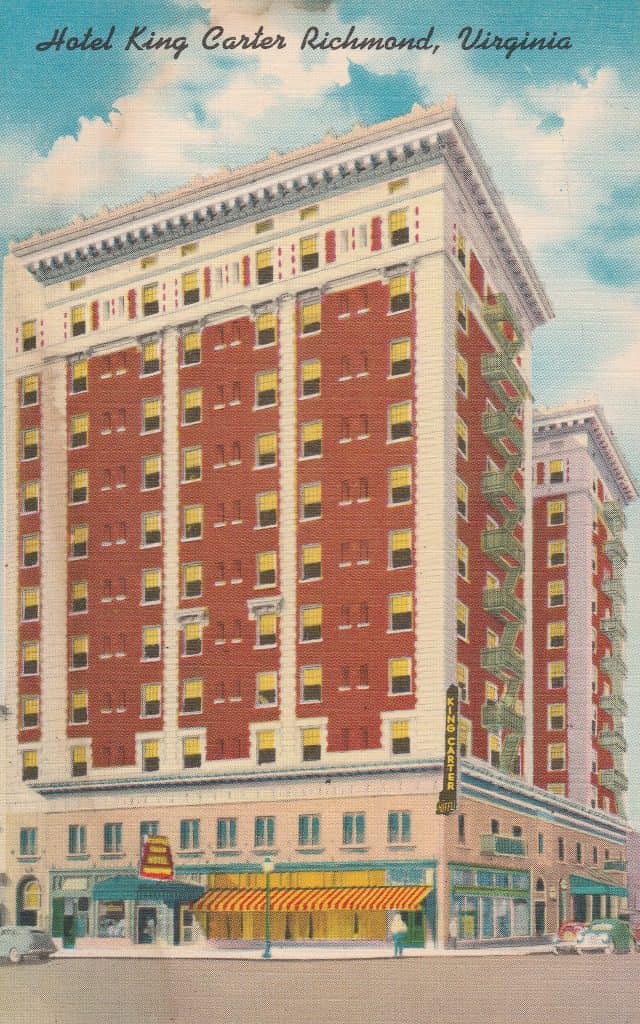
Richmond Hotels Corporation operated four hotels in the center of Richmond. They were Hotel Richmond and Murphy’s Hotel adjacent to Capitol Square, the John Marshall, and the William Byrd.
Murphy’s Hotel has the longest history. At the corner of Eight Street and Broad Street, John Murphy, an Irish immigrant and Confederate veteran, erected a hotel in 1872. In 1913, he replaced it with a modern thirteen story hotel. Richmond Hotels Incorporated took control of the hotel in 1939 and renamed it the Hotel King Carter in 1949. Robert Carter (1664 – 1732), “King Carter,” was one of the wealthiest men in the thirteen colonies, making his fortune as a tobacco planter and merchant. In the late 1960s, the hotel was sold to the Commonwealth of Virginia to house state offices. By the 2000s, the building had deteriorated and was torn down in 2007.
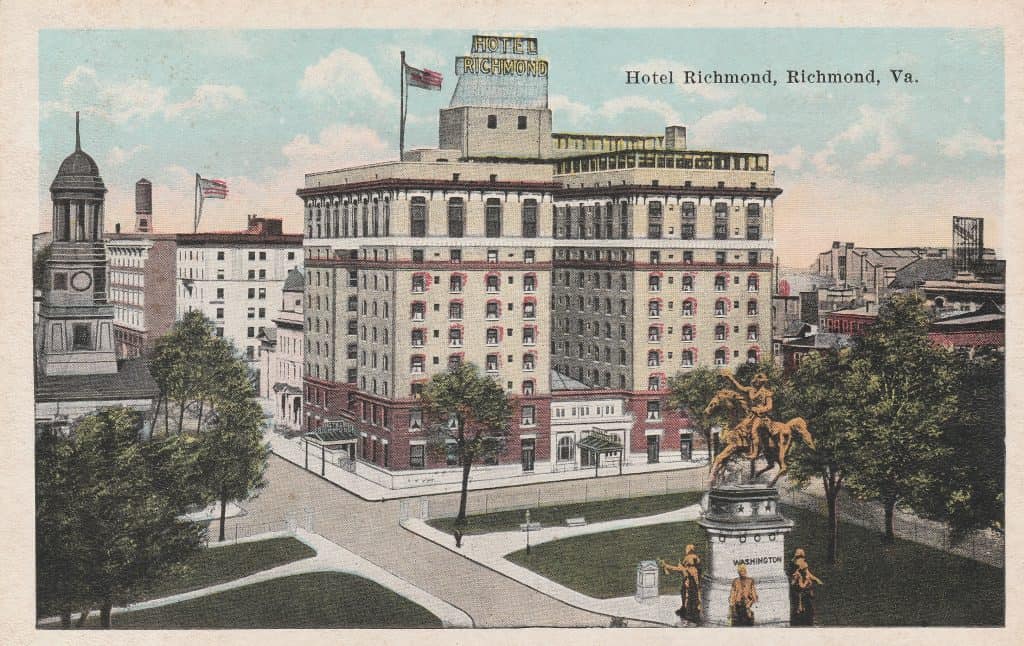
The ten story Hotel Richmond overlooks Capitol Square. Built in 1904, its location across 9th Street from the Virginia Capitol, made it the center of Virginia’s political life. The Byrd Machine, which dominated Virginia’s government from the 1920s through the 1960s, maintained its headquarters in the hotel. Among the features of the Hotel Richmond were a roof garden, an auditorium that seated 1,000, and an Italian marble lobby. The Commonwealth of Virginia took the hotel in the 1970s for offices. It was renovated in 2016 and now houses the offices of Virginia’s Attorney General.
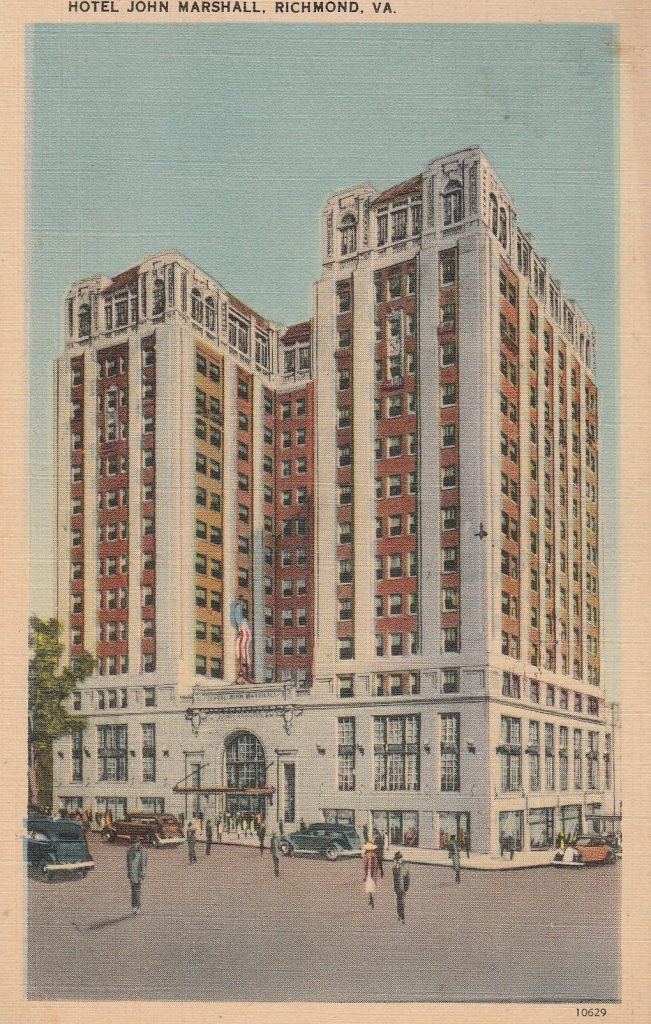
Along with the Jefferson Hotel, the John Marshall Hotel was one of the places to stay in Richmond for many years. Named for the former Chief Justice of the U. S. Supreme Court, whose home still stands a few blocks away, the hotel opened in October 1929, the day after the stock market crash. When it was built, its 418 rooms made it the largest hotel in Virginia. The hotel is neoclassical in design with some Moorish and art deco touches thrown in. One of the hotel’s best features was the 16th floor ballroom. In the 1930s, the John Marshall charged $3 a night for a room.
Unlike many grand hotels of the early 20th century, the Hotel John Marshall was spared the wrecking ball. In 2007, its new owners began a $70 million renovation and conversion of the hotel into 238 luxury apartments. Unfortunately, the rooftop ballroom was turned into penthouse apartments, but two lower floor ballrooms are still open for functions.
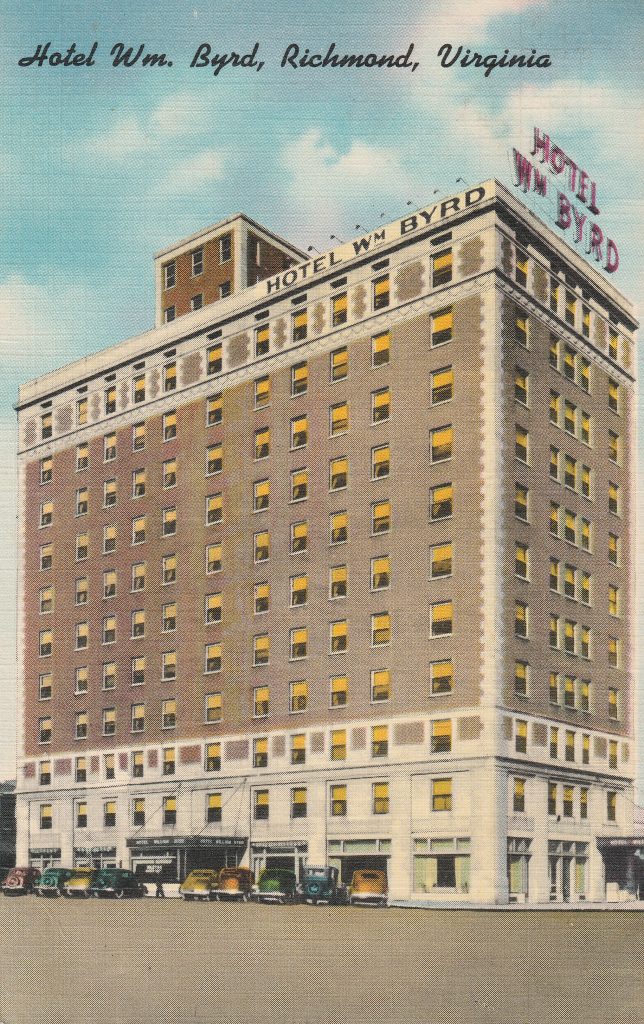
The Hotel William Byrd was named for the Virginia planter, statesman and author (1674 – 1744) who is considered the founder of Richmond. The hotel opened in 1925 and was located across from the Broad Street Railroad Station, approximately 2.5 miles from downtown. Eleven stories tall, it is an example of classical revival architecture. Due to its prime location across from the station, it prospered until the decline of passenger railroad traffic. The hotel ceased operations in the 1980s and was converted to apartments for low-income seniors in the 1990s.
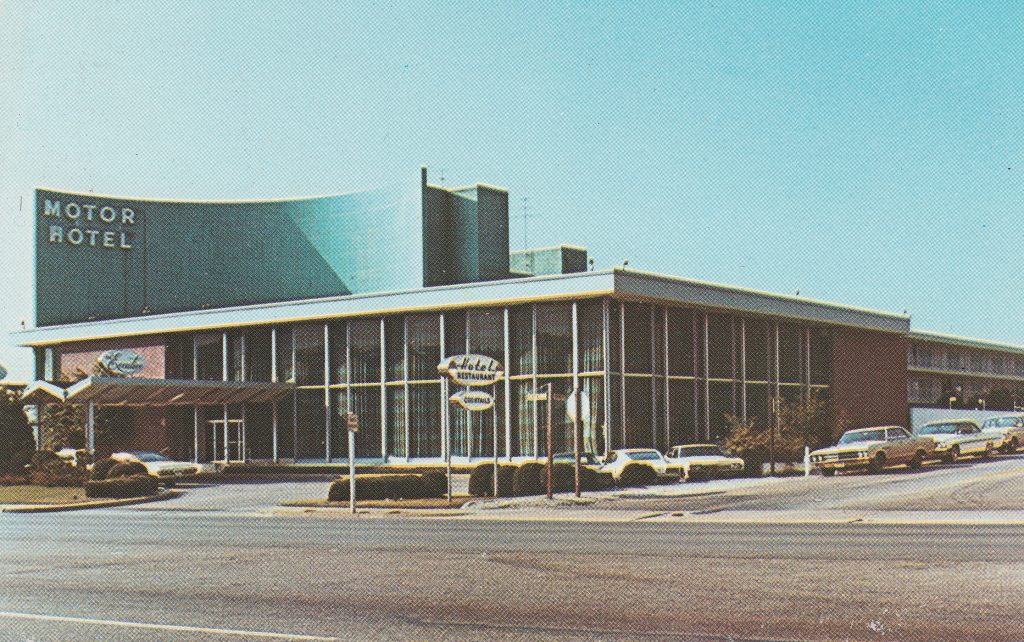
The Executive Motor Hotel was located in Richmond’s suburban West End near Willow Lawn Shopping Center. When it opened in 1960, there were 140 guest rooms and an outdoor pool with underwater speakers for music. A masterpiece of Mid-Century Modern Architecture, it had a curved, three-story exterior wall and an expansive glass lobby that proclaimed that Richmond had entered the 20th century. The lobby had a large, curved staircase and space age lighting. It was demolished in 2009.
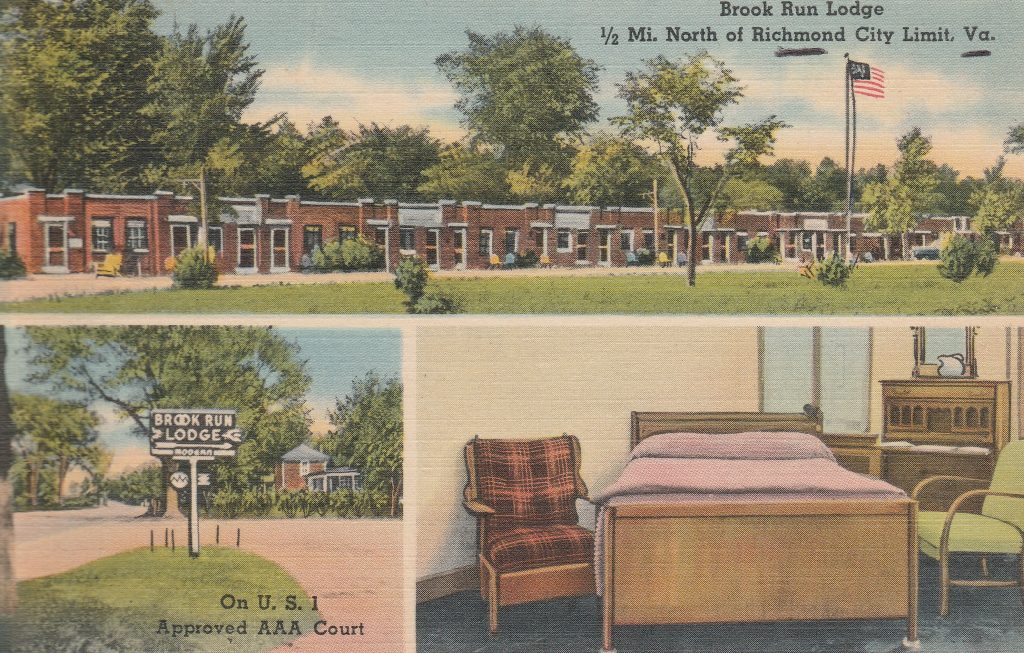
Before Interstate 95 was completed, Route 1/Route 301 were the major north-south corridors on the east coast. The two routes converged just north of Richmond and ran through the center of the city, then down to Petersburg before splitting again. The road north of downtown Richmond, Brook Road, had dozens of lodging establishments like the Brook Run Lodge. Located fifteen minutes north of downtown, the Brook Run Lodge had 25 brick cottages all with private baths and steam heat.
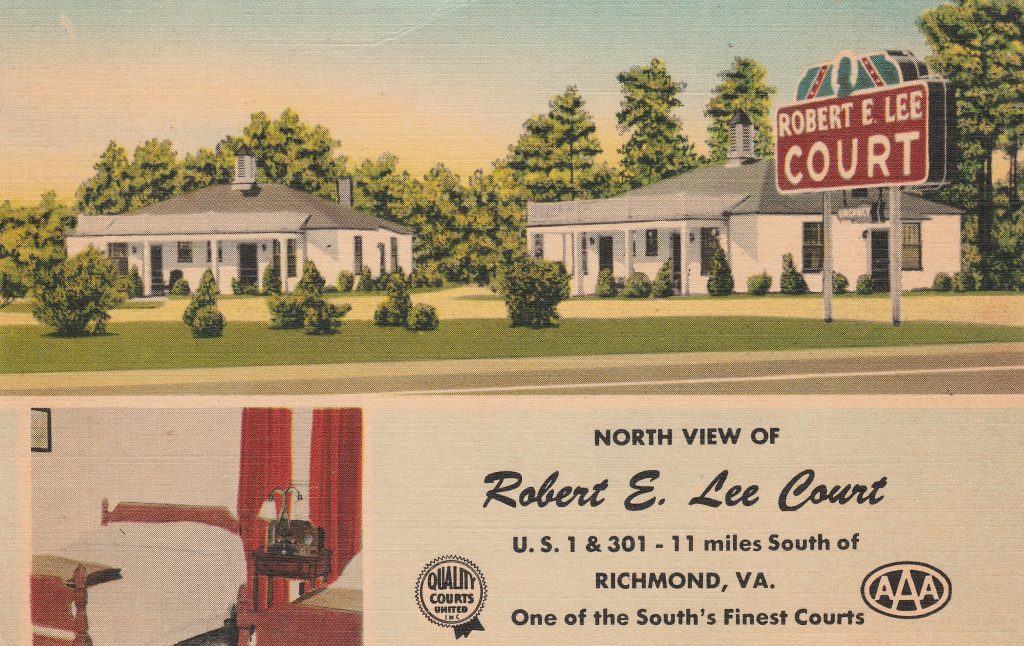
Route 1/Route 301 south of the James River was named Jefferson Davis Highway and was dotted with motels like the Robert E. Lee Court. Like the grand hotels in Richmond named for famous generals, the modest tourist court was named for a famous Virginian, Confederate General Robert E. Lee. Incidentally, Lee was a great-great grandson of King Carter. Located in Chester, Virginia, the back of the postcard proclaims that the Robert E. Lee is ultra-modern and new throughout with four air-conditioned rooms and was one of the South’s finest courts.
To speed traffic through Richmond and relieve congestion, the combined Route 1/Route 301 through Richmond was only four lanes, much of it undivided. To ease traffic concerns, the Commonwealth of Virginia created the Richmond-Petersburg Turnpike Authority in the mid-1950s. The turnpike opened in July 1958 and later became part of I-95. The motels and tourist courts along Route 1/Route 301 were bypassed and withered on the vine as national chains like Holiday Inn and Howard Johnson’s built motels at the I-95 interchanges. A few of the motels that survived until the 21st century, became centers of prostitution and drug dealing or were demolished to make way for shopping centers.
It’s good to know that many of these hotel buildings survive, even if some now serve purposes other than providing lodging.
Lots of history with the big city hotels. Thanks for sharing.
Hopefully the hotels described will flourish and continue in the life of the city. Thanks for this article.
Great article and postcards as well. I enjoy collecting vintage motel and hotel cards, from small mom and pop cabin types to the most opulent and posh hotels. They really reveal a lot about trends and how we have lived at any particular point in time.